I just invested half of my $1,400 stimulus check — here's why
Why I decided to invest my stimulus check with Robinhood

As someone who’s eligible for the third stimulus check, but fortunate to have kept up with my bills and expenses throughout the pandemic, I decided to put some of my newfound funds into the stock market.
By some, I mean half, with the other $700 that was just deposited in my bank account going to my local charities.
According to a recent survey from Deutsche Bank (via CNBC), I’m not the only one using part of my government payment towards my investment portfolio. A majority of respondents ages 18-24 with existing investment accounts said they planned to use 40% of their stimulus checks on stocks.
Except I’m not an existing investor. In fact, I’ve made a conscious effort to avoid any conversation with the word “stock” in it unless it's related to a chicken-soup recipe. Stock trading has always seemed complicated, time-consuming and difficult to pick up.
Then, earlier this year, I learned about the Robinhood app. In wake of the GameStop stock surges caused by organized Reddit users, Robinhood was one of several trading platforms that surged to the top of mobile app stores.
Robinhood also notably infuriated users when it shut them out from buying more shares of controversial stocks targeted by the r/WallStreetBets thread.
Not only did this episode mark one of the wildest free-trading parties the stock market has ever seen, but it sparked actionable interest in the stock market among young adults, too. For the first time, participating in the stock market seemed accessible to me.
Sign up to get the BEST of Tom’s Guide direct to your inbox.
Upgrade your life with a daily dose of the biggest tech news, lifestyle hacks and our curated analysis. Be the first to know about cutting-edge gadgets and the hottest deals.
When I installed Robinhood, I learned just how accessible it really is. Setting up an account took just a few minutes.
Once I entered my basic information, the app reminded me that I wouldn’t need to pay commissions or fees in order to trade stocks or other tradable securities. It even offered me a free share in a scratch-off-style welcome game.
In fact, the Robinhood app almost entirely gamifies the practice of trading. You swipe up to submit trades, and are greeted by confetti when your purchase is complete. While this could obviously perpetuate risky trading, it’s made investing by myself less intimidating.
Of course, I didn’t up and spend all $700 on stocks in one sitting. I’m using the Robinhood app to track the values of top stocks through the app’s lists, which let you organize any group of names and view their daily trend at a glance.
Actually, choosing which stocks to invest in is already complicated: When I think about the companies with which I spend my money or just know a lot about, I default to the tech sector.
But because I write news and reviews of products made by these companies, I’m steering clear of supporting them through personal investments. Instead, I’m optimistic that the travel industry will pick up as more people are vaccinated. I’m optimistic about the success of companies creating vaccines, too.
Might I be off base? Duh. I’m one day into trading, so you definitely shouldn’t take any market advice from me. But I do know what it feels like to be mentally alienated from investing in stocks. Starting your portfolio with your stimulus check could give you the chance to learn something new, while possibly growing your $700 into something more.
If you’re still waiting on your stimulus check, check our guide to stimulus check tracking. We also explain how the stimulus check for children works.
Kate Kozuch is the managing editor of social and video at Tom’s Guide. She covers smartwatches, TVs and audio devices, too. Kate appears on Fox News to talk tech trends and runs the Tom's Guide TikTok account, which you should be following. When she’s not filming tech videos, you can find her taking up a new sport, mastering the NYT Crossword or channeling her inner celebrity chef.

